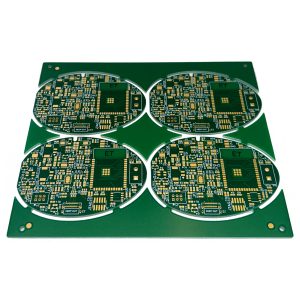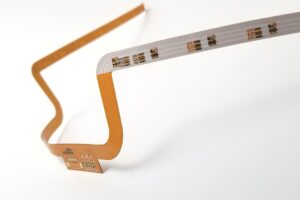Choosing the right printed circuit board (PCB) is crucial to your project’s success—whether you’re building a wearable device, a smart car sensor, or advanced medical tech. But with options like rigid, flex, and rigid-flex PCBs, how do you know which one fits your needs best? This guide breaks down the key features, benefits, and industry use cases of each PCB type to help you make an informed decision and design with confidence.
In this comprehensive guide, we’ll explore the unique characteristics, benefits, and best-use scenarios for rigid, flex, and rigid-flex PCBs. We’ll also dive into real-world applications in the medical, automotive, and consumer electronics industries to help you determine which PCB type is the best fit for your needs.
Types of PCBs Explained
Rigid PCBs
Rigid PCBs are the most traditional type of circuit board. As the name implies, these boards are inflexible and constructed from solid substrates like fiberglass (FR4). Once manufactured, a rigid PCB cannot be bent or modified in shape.Key Characteristics:
- Durable and structurally stable
- Cost-effective for simple to moderately complex circuits
- Easy to manufacture and test
Flex PCBs
Flexible PCBs, or flex circuits, are made from flexible plastic substrates such as polyimide. These can be bent, folded, and twisted without damaging the circuitry, making them ideal for compact and dynamic applications.
Key Characteristics:
- Extremely lightweight
- Flexible and adaptable to tight spaces
- Can reduce assembly costs by eliminating connectors and cables
Rigid-Flex PCBs
Rigid-flex PCBs combine the best of both worlds by integrating flexible circuits within rigid boards. This hybrid approach offers structural integrity where needed while allowing flexibility in other areas.
Key Characteristics:
- Space-saving and lightweight
- Improved reliability with fewer interconnects
- Ideal for compact, complex devices
Key Differences Between PCB Types: Flexibility, Cost, and Durability
The primary difference between rigid and flex PCBs lies in their physical construction and application potential. Rigid PCBs offer mechanical support and are ideal for devices that do not require movement. In contrast, flex PCBs are designed for dynamic applications where flexibility and space savings are crucial.
Comparison Table
| Feature | Rigid PCBs | Flex PCBs | Rigid-Flex PCBs |
|---|---|---|---|
| Flexibility | None | High | Moderate (in flex areas) |
| Durability | High (in static use) | High (in dynamic use) | Very high |
| Cost | Lower | Higher | Highest |
| Complexity Handling | Moderate | High | Very High |
| Assembly Requirements | Separate connectors | Fewer connectors | Integrated components |
PCB Applications in Medical, Automotive, and Consumer Electronics
Medical Industry
Rigid PCBs:
- Used in large, stationary diagnostic equipment like MRI and CT scanners
- Benefits: High reliability, strong structural integrity, and ease of mass production
Flex PCBs:
- Found in wearable health monitors, hearing aids, and implantable devices
- Benefits: Biocompatibility, lightweight design, and adaptability to human anatomy
Rigid-Flex PCBs:
- Integrated into surgical tools, pacemakers, and endoscopic equipment
- Benefits: Allows for complex geometries and reliable signal integrity in critical applications
Example: An implantable heart monitor uses a rigid-flex PCB to maintain stable connections while accommodating movement within the body.
Automotive Industry
Rigid PCBs:
- Common in control panels, infotainment systems, and engine control units (ECUs)
- Benefits: Robust and withstands vibration in static parts
Flex PCBs:
- Employed in lighting systems, sensor arrays, and dashboard instrumentation
- Benefits: Space-saving, vibration-resistant, and lightweight
Rigid-Flex PCBs:
- Used in advanced driver assistance systems (ADAS) and in-cabin electronics
- Benefits: High reliability and design versatility in compact spaces
Example: A rear-view camera module might use a rigid-flex PCB to connect image sensors and processors while withstanding continuous movement and vibration.
Consumer Electronics
Rigid PCBs:
- Found in TVs, desktop computers, and game consoles
- Benefits: Economical for high-volume production
Flex PCBs:
- Integral to smartphones, fitness trackers, and foldable devices
- Benefits: Slim form factor and flexibility for innovative designs
Rigid-Flex PCBs:
- Used in high-end laptops, cameras, and VR headsets
- Benefits: Space-efficient with minimal internal wiring, boosting durability
Example: A foldable smartphone depends on a rigid-flex PCB to bridge flexible and rigid components while allowing for repeated folding and unfolding.
Benefits of Rigid, Flex, and Rigid-Flex PCBs: Which Is Right for You?
Rigid PCB Benefits
- Lower cost for high-volume production: Ideal for budget-conscious projects, especially when designs are relatively simple and static.
- Simplified manufacturing and testing processes: Straightforward design reduces the chance of manufacturing defects.
- Strong mechanical support for components: Ensures long-lasting performance in fixed applications.
- Reliable performance in predictable environments: Perfect for desktop electronics, industrial machinery, and stable equipment.
Flex PCB Benefits
- High design flexibility: Ideal for 3D configurations and devices with moving parts.
- Reduced weight and space: Key for portable and miniaturized devices.
- Fewer connection points, improving reliability: Less prone to mechanical failures due to reduced solder joints and connectors.
- Excellent resistance to vibration and movement: Great for dynamic environments like wearables and automotive interiors.
- Enhanced thermal management: Can be designed for better heat dissipation in compact layouts.
Rigid-Flex PCB Benefits
- Combines strength and flexibility: Best of both worlds—rigid for stability, flex for adaptability.
- Fewer solder joints, reducing failure points: Higher durability in critical and high-stress applications.
- Ideal for complex and compact devices: Makes it possible to design products with intricate electrical paths and tight spatial constraints.
- Streamlined assembly process: Reduces the need for multiple PCBs and connectors, simplifying manufacturing.
- Improved signal integrity and EMI performance: Fewer connectors result in less signal loss and interference.
How to Choose The Type of PCBs for Your Project
To decide which PCB type is best for your project, consider these questions:
- Does the device need to bend or flex during use? If yes, consider flex or rigid-flex PCBs. These are ideal for wearable devices, foldable gadgets, or assemblies with moving parts.
- Is your device space-constrained? Flex and rigid-flex PCBs offer superior space utilization by fitting into unconventional shapes and compact enclosures.
- What is your budget? Rigid PCBs are the most cost-effective for simple applications. Flex and rigid-flex PCBs require more investment but deliver higher functionality.
- What is the expected lifecycle and environment of the product? Harsh environments or high-vibration settings benefit from the resilience of rigid-flex PCBs.
- How critical is reliability? Devices where failure is not an option (e.g., medical implants or automotive safety systems) should lean toward rigid-flex designs.
- What level of assembly complexity can you handle? Rigid-flex PCBs can simplify assembly by integrating multiple boards into a single unit, reducing labor and errors.
- Are aesthetics or compact design important? Flex and rigid-flex PCBs allow for sleeker, thinner, and more visually appealing product designs.
🧠 Pro Tip:
When in doubt, consult an expert! Matching your design requirements to the right PCB type early in the process can reduce rework, speed up prototyping, and lower production costs.
Let OnBoard Circuits Help You Decide
At OnBoard Circuits, we specialize in manufacturing high-quality PCBs tailored to your application. An array of PCB design software such as KiCad, Altium or CircuitMaker, can be used to regardless of the type of PCB required by your application. Whether you’re developing next-gen medical tech or cutting-edge consumer gadgets, our team can guide you to the best solution.
Explore Our Services
When you work with OnBoard Circuits you receive our knowledge and experience, resulting in high-quality printed circuit boards and unparalleled customer service. Learn more about our PCB capabilities.
Get a Free Consultation
Understanding the differences between the different types of PCBs is critical for building a product that’s not only functional but also efficient and reliable. With the right PCB, you can unlock new design possibilities and ensure long-term performance across various applications. Trust OnBoard Circuits to be your partner in bringing innovative electronic products to life.
Our experts are here to help. Contact us today for a free consultation and let’s find the best PCB solution for your needs.







